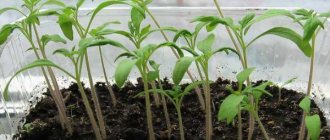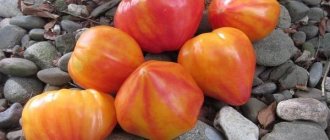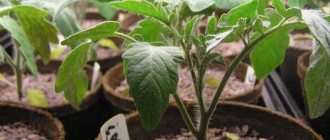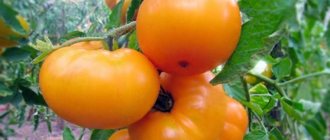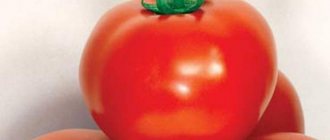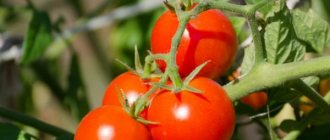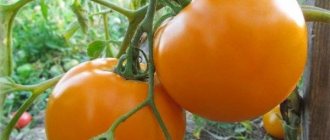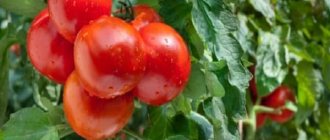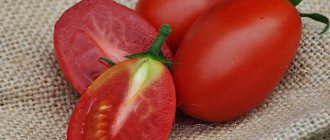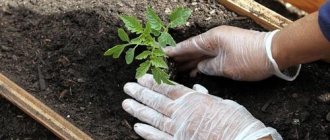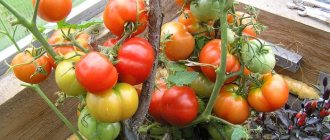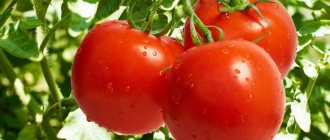often pleases summer residents with new varieties of tomatoes. One of them is Skorospelka. Its main advantage is the possibility of obtaining a super early harvest.
| Height | Landing location | Ripening time | Fruit color | Fruit size | Origin | Fruit shape |
| short | Open ground | Ultra early | Reds | Average | Variety | Flat-round |
Description of the variety
Tomato variety “Skorospelka” is ultra-early ripening. The first fruit ripens already 87-95 days after sowing the seeds. The variety bears fruit well both when grown in open ground and in greenhouses. The height of the bush reaches 50-70 centimeters. Plants require moderate pinching and fastening to a support.
Subspecies of the variety
In addition to simple early ripening, the following hybrids are distinguished:
- “Syzran early ripening” - a tomato bred by breeders from the city of Syzran, Vladimir region. The main distinctive characteristics of the variety include: tall indeterminate bush, up to 180 cm high; plum-shaped fruit with a sharp nose and crimson skin color at ripeness.
- Tomato "People's early ripening" - bred and improved for the northern regions of Russia. It is distinguished by smaller fruits (up to 100 g), increased yield, dense pulp and sweet taste.
Distinctive features
The peculiarities of the “Skorospelka” variety include the unusually earlier ripening of fruits, even in comparison with other early ripening varieties. For an early variety, the tomato has impressively sized fruits and is resistant to temperature changes in the spring, when the plant is just beginning to take root after being planted in a permanent place of growth.
Fruit characteristics and yield
The fruits have a round, slightly flattened shape . The skin of ripe fruits is red, however, with uneven lighting an orange tint is observed.
The pulp has a high content of useful substances, has a sour-sweet taste and a pronounced aroma. The average fruit weight ranges from 130 to 150 g. The average yield of one branch is 6-7 fruits or 5-7 kg per 1 sq. m landings. The flowers are simple, white with a yellow base.
Good to know:
How to properly spray tomatoes with potassium permanganate
How to deal with tomato pests
Prevention of diseases and pests
Tomatoes belong to the category of garden crops that are of great interest to many insects and are also susceptible to a number of diseases. A similar negative point was not spared by the “Skorospelka” variety.
You will probably be interested in reading about how to deal with dangerous diseases and pests of tomatoes.
Below is a list of the most common tomato diseases and methods to combat them.
- Streak. It differs in that the affected plants have curled and limp leaves, all fruits and flowers fall off, and sometimes the plant itself dies. To prevent such a virus from infecting the tomato, it should be planted in a sunny place and away from other plants of the Solanaceae family.
- Verticillium wilt. Below, the leaves begin to turn yellow, dry out and fall off. The leaves curl and the plant stops growing, but death does not occur. Prevention can be achieved by timely application of fertilizers and removal of all plant debris (including cut weeds) from the site. If such a lesion occurs, the diseased plants should be removed to prevent further propagation of the infection.
- Cracks on the surface of tomatoes occur due to too much moisture, especially if there has been a drought before. Cracks are dangerous because infectious lesions penetrate into them, which cause rotting. To preserve the fruits, you need to water regularly.
- Late blight. Multiple brown spots of putrefactive lesions appear throughout the entire body of the plant, and a whitish coating covers the foliage below. Prevention of late blight: timely application of fertilizers and compliance with neighborhood rules (cannot be planted next to potatoes and other Solanaceae). In case of illness, all tomatoes are sprayed with the preparation “Zaslon”, and a week later with “Barrier”. One of the folk remedies that helps is an infusion of garlic (5 crushed cloves per 1 liter of water).
- Fomoz.
Tomato fruits are affected by large purple spots up to 3-4 centimeters in diameter. The affected area appears concave in appearance, because putrefactive processes penetrate inside the tomato. Excessive humidity contributes to this disease. If such a disease is detected, the affected fruits are removed and the bushes are sprayed with the preparations “Hom”, “Oxyx” or Bordeaux mixture. Did you know? The secret to watering tomatoes, which will significantly reduce the frequency and susceptibility of diseases, and also increase their growth rate, is to add a few handfuls of ash to a bucket of water. And dusting the soil with ash around the stem at the rate of one handful per 1 square meter will help you increase fruiting. m. - Bacterial spotting. Leaves (scarred with small brown spots) and fruits (large depressed dark spots around which a light border forms) are affected. It is dangerous due to the complete death of the plant. Treatment is carried out with a solution of Bordeaux mixture and copper sulfate. Prevention consists of timely application of fertilizers, which should include copper and nitrogen. Withered bushes are removed.
- Blackleg. This disease is more common among seedlings and young plants. The bottom of the stems becomes covered with black spots, and the plant dries out. Tomatoes should be watered sparingly. For prevention, you can water the bushes with a solution of potassium permanganate (1-1.5 g of dry matter per 10 liters of water).
- Whitefly. This insect, whose name fully describes its appearance, covers the tomato greens with secretions, thanks to which sooty fungi begin to develop, as a result of which the bush turns black and dies. We recommend fighting the pest with the drug “Confidor”.
- Slugs. They destroy the foliage and contribute to the appearance of rot on the fruits. To combat, use ash, tobacco dust or slaked lime, which is sprinkled on the ground around the stem.
- Spider mite. Having entangled the leaves in a web, it drinks the juice from them, contributing to the drying out and further death of the plant. To fight, use “Karbofos” or a folk remedy in the form of garlic infusion.
- Medvedka. Destroys roots, contributing to the death of the tomato. To combat, the drug “Thunder” or a folk remedy in the form of an infusion of hot pepper with vinegar is used.
- Wireworm. This bright yellow larva eats the roots of the tomato, often burrowing into the stem. For control purposes, it is recommended to use the drug “Bazudin”.
- Gnawing owls. This dark gray or black caterpillar destroys the foliage and stems of tomatoes. To defeat them, tomatoes are sprayed with the drug “Strela”.
How to grow seedlings
Let's consider step by step how to grow viable and productive seedlings for this variety .
Seed preparation
You can sow the seeds dry, but it is better to soak them first , because
This will not only increase and speed up germination, but will also allow the selection of low-quality seed material. Selecting a solution for soaking seeds:
- a weak solution of potassium permanganate (pick the powder onto the tip of a match and dissolve in 1 liter of water);
- ash solution (dissolve 2 tablespoons of powder in 1 liter of boiling water);
- solution of the drug "Fitosporin-M" (the dosage is indicated on the packaging of the drug).
This procedure will disinfect and disinfect the soil , accelerate seed germination and increase the plant’s protective functions against various diseases. Seeds that float to the surface during soaking are discarded and not used for planting.
Container and soil
For growing seedlings, there is a large assortment of ready-made soils on sale . To make your own soil, mix garden soil, peat and sand in equal parts. Pour the resulting soil into a box.
In terms of alkaline composition, slightly acidic soil with a pH of 5-6 is preferable. It is very convenient to use containers specially made for this purpose or the most ordinary food containers from a hardware store as a planting box.
Sowing
It is optimal to plant early ripening tomato seeds 50-60 days before the expected date of planting the plant at a permanent growing location . In the prepared planting box, distribute the seeds over the surface of the ground and sprinkle with a little earth.
The height of the soil layer should not exceed 1.5 cm. Water with warm water and after 6-7 days the first shoots will become visible. Temperatures below +24 degrees at this time can harm fragile plants.
Growing and care
As soon as two leaves appear on the seedlings, we begin picking them. This occurs approximately on the 15-21st day. When transplanting a seedling, you should deepen it to the cotyledons (lowest) leaves and protect it from direct sunlight for several days for adaptation. For good growth and health of seedlings, a special temperature regime is important. During the day, keep the temperature from +20 to +25 degrees, and at night not lower than +18 degrees.
When watering, seedlings like moderation: excessive moisture will lead to the development of diseases (for example, blackleg) and the death of the plant. Water the young shoots only when the soil dries out a little. The seedlings are fed once every two to three weeks. Fertilizers based on potassium and phosphorus are mainly used for feeding.
Other varieties of tomatoes:
Why are Minusinsk tomatoes valuable?
How to grow Red Giant tomato
How to grow Black Elephant tomato
Tomato care
The “Skorospelka” variety is resistant to diseases and pests. Therefore, crop care is minimal and consists of the following activities:
- Loosening the soil. Tomatoes prefer to grow on loose soil. The procedure is important; it allows you to remove the soil crust.
- Watering. Tomatoes respond well to soil moisture. This is especially true in hot weather. Experienced gardeners additionally recommend using drip irrigation.
- Feeding. Over the course of the entire season, fertilizing is required several times.
- Tying. To prevent the stems from breaking, it is necessary to install a support and tie up the plants.
How to grow tomatoes
Landing
12 days before planting in a permanent place, seedlings begin to harden . Plants are placed in open sun for several hours a day and at a temperature of +10 to +15 degrees.
To prevent diseases, the soil is treated with a manganese solution before planting in open ground .
No more than 6 plants are planted per square meter . A mixture of soil and humus is added to the bottom of the planting hole.
Advice! After planting, it is advisable not to water the plants for 7-10 days. This way their root system will form stronger and the roots will go deeper.
Plant care
Let's consider the main principles of plant care.
Lighting
Tomato is a heat-loving and light-loving plant. The brighter and more intense the light, the better . The most favorable temperature is considered to be from +20 to +25 degrees. From lack of light, the plant stretches and weakens.
Watering
Tomatoes do not like too frequent watering. It is optimal to water abundantly once a week.
Effective and convenient methods include drip irrigation, when a thin tube is connected to each plant, from which the plant constantly receives a small amount of water.
Tomatoes respond to such watering with increased fruiting and larger fruits.
Weeding and loosening
Regular weeding and loosening of the soil will improve the circulation of oxygen at the roots of the plant , making it more efficient at absorbing the necessary nutrients and elements.
The hard crust of the earth will not only create unfavorable conditions for the roots, but can also damage the delicate skin of the stem, which will weaken it against fungal and bacterial infections.
Pinching and shaping the bush
7-10 days after planting the plants, pinching is carried out. It is optimal to grow an early ripening bush with three stems. To do this, two lower stepsons are left on the main stem. All other stepsons on the plant are removed.
Try to remove the stepsons before they reach a length of 3-4 centimeters. When breaking off a stepson, it is preferable to leave a small stump, so the growth of stepsons in this sinus will be stopped.
Garter
The early ripening bush has a fairly spreading bush that requires garter . Seedlings are tied up immediately or after 6-7 leaves appear on it. The bushes are tied up: to a stand, which is installed 10 cm from the plant; to a trellis with tensioned wire or to greenhouse guides.
Top dressing
At different stages of plant growth, plants use fertilizers of different compositions . Thus, at the growth stage of a young plant, it requires nitrogen-containing fertilizers, and during flowering and fruiting, potassium-phosphorus fertilizers.
Important. It is important to use nitrogen fertilizers only according to the instructions, strictly following the prescribed dosage! A lack of nitrogen will slow down the growth of the bush, and an excess will slow down the formation of fruits.
Features of cultivation and possible difficulties
Skorospelka is an undemanding plant . It is enough to provide it with regular watering, loosen and weed the soil, periodically pamper it with mineral and organic fertilizers, and the plant will thank you with a generous harvest.
Hill up tomatoes twice a season , this will allow the plant to grow additional roots from the stem.
Diseases and pests
The “Skorospelka” tomato variety is unpretentious and has good immunity , however, for prevention and additional protection it is advisable to use microbiological preparations (for example, “Fitosporin”).
(spider mites, aphids, caterpillars and others) are found on the plant
Advice! To prevent late blight from settling in the greenhouse, open and place 2-4 bottles of regular iodine from the pharmacy in it at an equal distance! Its vapors will effectively fight spores of fungal infections and pathogens of bacterial diseases!
How to harvest and store the crop?
Harvesting can be done as early as June. If you plan to eat tomatoes fresh, as well as use them for canning, making tomato juice or paste, it is better to pick them at the moment when they are fully ripe and turn red. This occurs 80-90 days after sowing the seeds. If you plan to salt or store Skorospelka, the fruits can be collected earlier, when they are still green, milky or pink.
Before storing, sorting should be carried out, identifying and removing fruits with mechanical or other damage. The densest and most elastic tomatoes should be placed in plastic or wooden boxes so that each of them weighs no more than 12 kg. They should be kept in a dark and cool place, such as a basement or pantry. However, it should not be damp, since in this case fungal and putrefactive lesions will appear on the tomatoes. To prevent damage to the crop, the room must be regularly ventilated, for example, by opening the doors for several hours.
Early ripening is a fleshy and elastic variety, so tomatoes retain their original shape for a long time. However, you should not forget about them for a long time so that they do not deteriorate. So, they should be used for their intended purpose in the coming weeks after harvest.
Selected tomatoes can be transported in boxes to prevent them from choking and leaking juice.
Advantages and disadvantages of the variety
Advantages of the variety:
- unpretentiousness and good immunity of the plant;
- the bush blooms and bears fruit early, late blight appears much later;
- simultaneous ripening of a large number of fruits, which is convenient for harvesting;
- good transportability of fruits, resistance to mechanical stress;
- high yield at low temperatures;
- increased content of nutrients in fruit pulp;
- Suitable for growing both in open ground and in greenhouses.
Disadvantages of the variety:
- the need to remove stepsons and tie plants to a support;
- relatively low yield (compared to later varieties);
- lower sugar content (compared to later varieties).
How to increase productivity
The Siberian early-ripening variety is low-growing, and for this reason there are only 3 - 4 inflorescences of 5 - 6 flowers on its main stem. To increase the yield, plants are not planted with stepsons or only part of the stepsons are removed. This allows you to harvest from side shoots.
Also, to increase yield, it is necessary to remove the fruits when they reach blanche ripeness. In this case, the plant directs its forces to the development and ripening of the remaining berries.
Tomatoes should ripen in baskets or cardboard boxes at room temperature.
If you want fresh tomatoes on the table for as long as possible, leave them to ripen in a cooler room, but the temperature in it should not be lower than +10 °C. If it is lower, they will simply rot.
The fruits of this variety are intended for fresh use. They are suitable for salads. Very juicy. Due to this feature, they are used to make tomato juice. Tomatoes are also added to soups, sauces, pizzas and, in addition, frozen.
{SOURCE}
Farmer reviews
The experience of farmers cultivating early ripening on an industrial scale has shown tomato yields of 5-7 kg of tomatoes per 1 sq.m of planting . The fruits of the “Skorospelka” variety are most often used for the production of tomato juices.
In reviews of the “Skorospelka” tomato, gardeners note the high quality of the resulting preservation and the early timing of the first harvest.
Elena: “I bought the seeds according to the description, I had no growing experience. The result is excellent - the taste of canned tomatoes is beyond praise. At the same time, the fruits almost did not burst. I’ll plant again next year.”
Vladimir: “If you need an early variety, you won’t find better than Skorospelka. This is the third year I’ve been planting seedlings of these tomatoes and I always get a harvest before my neighbors in the country.”
Skorospelka tomatoes on video
If you grew Skorospelka tomatoes, please write whether you liked them or not. What was the yield and taste of the fruits like under your climatic conditions? How do you rate the disease resistance of this variety? If possible, attach a photo of the entire bush or individual fruits you grew to your comment. Thank you!
Your reviews of the Skorospelka tomato and additions to the description will help many gardeners evaluate this variety more objectively and decide whether it is worth planting or not.
This is a natural variety of tomato. Therefore, we recommend taking seeds from a ripe fruit and using them for planting in subsequent seasons.
Preparing and planting seeds
The first and most important issue in dealing with seeds is their proper preparation and determining the period for planting them.
You can sow tomato seeds either dry or after pre-soaking.
The following methods can be used for soaking:
- Instead of plain water, it is better to soak the seeds in a weak solution of potassium permanganate (manganese ore on the tip of a knife per 1 liter of water). Potassium permanganate will have a disinfecting and disinfecting effect.
- An ash solution is considered to be a fairly effective germination accelerator, when 2 tablespoons of ash are dissolved in a liter of boiling water and left for two days.
- If it is difficult for you to find ash, you can use special preparations that are sold in gardening stores and on the Internet. It will be effective to use “Fitosporin-M”, which simultaneously improves germination and increases the protective function of tomatoes against various diseases. If you treat the seeds with Fitosporin-M, you do not need to soak them in potassium permanganate.
Agricultural technology
To successfully grow tomatoes, you must meet a number of requirements:
- Prepare seedlings 55-60 days before they are supposed to be planted in the ground. As a rule, this period falls at the end of March.
- For Skorospelka, sandy and loamy soils with a pH in the region of 5-6 are optimal. Its best predecessors are cucumbers, cabbage and all types of beans.
- Maintain plenty of light as tomatoes love light. The brighter and more intense it is, the more actively the fruits will ripen. The lack of light will lead to stretching and weakening of the bushes, as a result of which the beginning of their flowering and fruiting will be delayed.
- In order for the seeds to begin to germinate, the temperature must be maintained within +14...+16°C, although its best indicators are +20...+25°C. If it drops to +10°C, the development and growth of the plant will slow down significantly and may stop altogether with a further drop in temperature. If it reaches -1°C, the plant will die completely.
In addition to fertilizing with complex mineral fertilizers, in order to obtain a good harvest, the plant must also be watered on time, fertilized and preventive measures must be taken to protect it from pests and diseases.
Fruit characteristics and yield
The fruits ripen on day 85. That's why the variety got its name. When ripe, the fruit becomes bright red with a flat-round shape. The fruits are medium in size and grow up to 150 grams. For an early variety, the fruit is very tasty and fleshy with a high content of nutrients.
The fruits are universal and are perfect for both fresh use and canning. At the same time, they are not afraid of high temperatures, and do not burst during processing. This variety produces good and tasty tomato juice.
The fruits are characterized by good keeping quality and transportability. Gardeners often use this variety for commercial purposes.
The fruits of this variety of tomatoes fully ripen already on the 85th day from the date of sowing the seeds and reach about 150 g of weight. These tomatoes are distinguished by their round, slightly flattened shape at the ends. When ripe, one side of the tomato has an orange tint, while the rest of the fruit is a uniform red color.
Its fruits do not burst from high temperatures and have excellent storage and transportation properties, because they are practically not damaged due to their high density and fleshiness. The average yield is considered to be 5-7 kg per 1 sq. m of landing area.
Did you know? There are more than 10,000 different varieties of tomatoes in the world. Interestingly, the size of the fruits of the smallest variety reaches 2 cm in diameter, and the weight of the largest variety of tomatoes sometimes exceeds 1.5 kg.
Features of cultivation and care
The variety is grown through seedlings. Seeds are sown 50-60 days before planting in the open air or in a film shelter. Before sowing, it is recommended to treat the seeds against diseases. You can speed up germination by treating them with stimulants.
Another interesting way to speed up seed germination is to spill the soil prepared for sowing with a hot solution of potassium permanganate (1 g per 1 liter of water).
Prepared seeds are placed in the uncooled soil, covered with dry soil, and covered with film. Before emergence, place in a warm place. Shoots appear on the 3-5th day. The sowing container is transferred to a bright place. Up to 6 bushes per 1m2 are planted in a garden bed.
The nuances of growing Siberian early ripening tomatoes
This variety grows well almost throughout Russia. The exception is the North Caucasus, the Volga region, and the Central Black Earth Region.
The use of fertile soil will help to fully realize the potential of the variety. Plants prefer slightly acidic, light, moist soil. To comply with the rules of crop rotation, it is necessary to choose beds on which cucumbers, onions, cabbage, and legumes grew in the previous season.
Preparing the soil for planting tomatoes begins in the fall.
- The beds need to be cleared of any remaining tops.
- Dig up the soil and add humus or compost.
- In the spring, when warm days arrive, mineral fertilizers, sawdust, and wood ash are applied.
- The soil is dug up again, and the holes prepared for planting seedlings are watered with a manganese solution at the rate of 1 g per 10 liters of water.
Rating of the best early ripening tomato varieties
Early varieties of vegetables planted on your site help replenish your vitamin supply after a long winter. You can get an early harvest of tomatoes by selecting seeds of early ripening varieties, planting seedlings, and further growing the plants in a greenhouse. Experienced vegetable growers receive their first harvests by the end of May. Which tomatoes to choose to get the earliest harvests? Based on reviews from gardeners, we have made a selection of the best early-ripening tomatoes. Photos will help you visualize the expected result.
